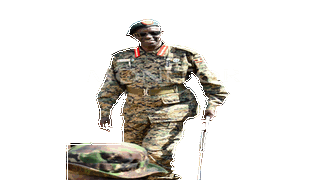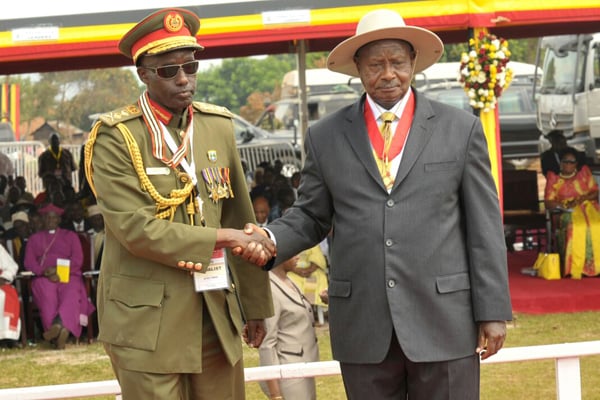
Gen Elly Tumwine. PHOTO/FILE
|People & Power
Prime
Gen Elly Tumwine: A legend in NRA folklore and history
What you need to know:
- During the NRA war, Gen Elly Tumwine, along with the late Lt Col Chefe Ali, composed most of the mobilisation songs.
- His prominence was tied entirely to the NRA dispensation. Prior to and after NRM, it would have been difficult to see, in him, a national hero.
The former National Resistance Army (NRA) commander and minister of Security, Gen Elly T. Tumwine, died of lung cancer in Nairobi on Thursday. The reaction to his death was predictable.
Those eulogising him recalled his place as the man who fired the first gunshot of the Popular Resistance Army (PRA) during its February 1981 assault on the Kabamba Infantry Training School, and praised his patriotism and fight against dictatorship in Uganda.
Those who openly celebrated his death or quietly chose not to mourn, mostly focused on his statement in November 2020 in which he declared that police had a right to use lethal force if public unrest spiralled out of control.
He was technically right about that police right to open fire.
However, this utterance, coming on the back of his tendency to speak arrogantly, came off like one calling for a brutal response to National Unity Platform (NUP) protesters, which is why so many of them celebrated his death.
How did Tumwine come to be perceived this way, as an arrogant, insensitive man?
This partly stemmed from his attitude and partly from the way President Museveni managed his politics.
Like most other prominent government and security officials today, Tumwine came to prominence as a result of belonging to the army and the political party created by Museveni.
He was, like most others, a Museveni appointee.
Without Museveni holding state power, there would be no Elly Tumwine enjoying public prominence.
Tumwine’s main claim to fame is having fired the first shot at Kabamba.
Some present during that attack say Tumwine fired more out of panic or recklessness than courage or tactical wisdom.
READ MORE: About Gen Elly Tumwine
Nevertheless, this act became part of NRA’s myth-making and gave him a prominent place in it. He was appointed commander of NRA in 1984 and served in this role until 1987, with NRA now in government.
After this, his role was unclear. He had little else to go or do.
Both Tumwine and Maj Gen Samuel Kasirye Gwanga had played an important role in the period leading up to NRA’s rise to state power in January 1986. There was no reward enough for Museveni to give them.
At the same time, there was little room for them in a new period in which the army had to be expanded beyond its NRA roots.
Tumwine was allowed free rein and his statements of bravado and dismissive tone tolerated, the same way Kasirye Gwanga was allowed to speak his mind and live his cavalier life.
That was the trade-off permitted by Museveni for military figures for whom no place could be found in the changing national climate, but who needed to retain their public prestige.
In that sense, Tumwine became a Moses Kigongo – a permanent fixture in the top hierarchy of the NRM state, for reasons unknown to most Ugandans, but for whom there was an unwritten rule that he was to remain NRM vice chairman and that office left uncontested.
In 1994, he was appointed director general of the External Security Organisation, an office that few remember him for.
Many years later, in the late 2010s, Tumwine would be minister of Security.
He tried to live imaginatively, trying his hand in fine art, fashion design, and music.
The results were decidedly mixed, mostly simplistic.
He was, in general, a patriotic but simplistic man in his thoughts and convictions.
He lacked the more intellectual rigor of Museveni in matters like economic development and historical evolution of society.
“Ankole culture, Christianity and the NRM revolution do not support corruption,” he stated in December 2011.
He was right in every sense in this statement, although the facts of the NRM government painted an entirely different picture.
People from Ankole who considered themselves devout Evangelical Christians and ardent NRM cadres were responsible for some of the most bizarre instances of corruption and impunity in Uganda’s post-independence history.
As army commander between 1986 and 1987, part of the road along Windsor Crescent in Kololo that went past his house was closed off to traffic, not for any sound reason but because of his sense of entitlement.
How he came to acquire the government-owned Nommo Gallery in Nakasero was also questionable.
In March 2021, an elderly woman in Ankole went public with accusations that Tumwine was in the process of grabbing her land.
During the NRA war, Tumwine along with the late Eriya Mwine (Lt Col Chefe Ali) composed most of the mobilisation songs.
In other words, his prominence was tied entirely to the NRA-NRM dispensation. Prior to and after the NRM, it would have been difficult to see, in him, a national hero.
In 1994, Tumwine and another NRA General David Tinyefuza (aka Sejusa) organised a cultural ceremony to install Ankole’s crown prince John Barigye as Ankole’s monarch.
This was at a time that the traditional kingdoms that had been abolished in 1967 by the Uganda Peoples Congress (UPC) government were being restored.
President Museveni, sensitive to the politics of Ankole and also having a vested interest in not having Bahima loyalty split between Barigye and himself, ordered the ceremony cancelled.
Tumwine and Tinyefuza never forgave Museveni for that.
Tumwine was from the Bahinda clan, Ankole’s direct royal clan, the way the Babiito are the royal clan of Bunyoro and Tooro. Tinyefuza’s wife Juliet is also a Muhinda.
Tumwine feigned unwavering loyalty to NRM and Museveni, but privately was more critical of both than his public posture suggested.
Some of Tinyefuza’s criticism of the NRM state after 1994 sprung from this foiled effort to restore Ankole’s monarchy.
In January 2018, Tumwine resumed his effort to restore Ankole’s monarchy, indirectly showing his continued displeasure at Museveni’s opposition to the Nkore kingdom.
It could be argued that part of Tumwine’s motivation for taking up arms against the second Obote government in 1981 was because of its abolition of the traditional kingdoms 14 years earlier.
Finally, following the 2021 general election after he was not appointed to the new Museveni Cabinet, he publicly called for Museveni to start preparing to step down from office and retire.
This call by Tumwine was jubilantly welcomed by many who this week celebrated his death.
He must have been reprimanded for that statement and probably also threatened, because after he uttered it, he went silent.
Tumwine, then, is a legend in NRA folklore and history. He was a product and functionary of the NRA-NRM.
It is at present the NRA-NRM’s time, and so history and current affairs in Uganda are inevitably viewed through the NRA era.
He is a hero in NRA-NRM circles, in the same sense in which Brig Isaac Maliyamungu and Col Juma Oris were luminaries in the Idi Amin regime.
He is a hero in the same way that Capt George Nkwanga and Maj Fred “Mpiso” Kiberu would have been legends of FEDEMU or UFM had either of these fighting forces seized state power in 1986 and not NRA.





